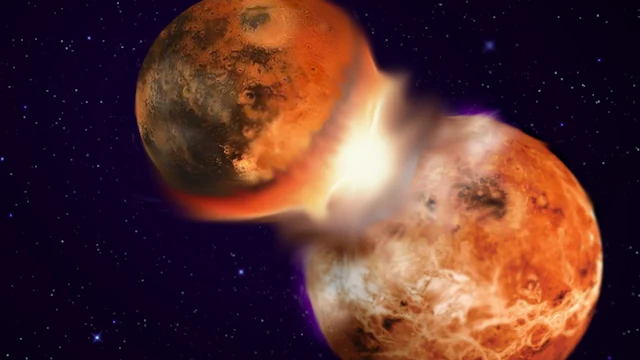Introduction
The origin of the Moon has long been a topic of fascination and scientific inquiry. The leading theory is that the Moon was created when a massive celestial body, often referred to as "Theia," collided with Earth in a catastrophic event early in the planet's history. While this theory is widely accepted, a new perspective has emerged, suggesting that the remnants of this impact may not just be confined to the Moon. Instead, some of Theia's remnants might still exist deep within Earth's mantle. In this 1000-word article, we will explore this intriguing hypothesis, its supporting evidence, and the profound implications it has for our understanding of Earth's geological history.
The Giant Impact Hypothesis
The Giant Impact Hypothesis, first proposed in the 1970s, provides the most widely accepted explanation for the Moon's formation. It posits that a celestial body roughly the size of Mars, often referred to as Theia, collided with the early Earth around 4.5 billion years ago. The violent collision led to the ejection of significant amounts of material into space, which later coalesced to form the Moon.
This hypothesis accounts for several key observations, including the similarities between Earth and Moon's isotopic compositions and the Moon's lower density compared to Earth, suggesting a smaller iron core. Furthermore, computer simulations support the plausibility of a giant impact event generating the Moon.
Theia's Remnants Inside Earth?
Recent research conducted by a team of scientists, led by Arizona State University's Qian Yuan, has reignited interest in the Moon's formation by suggesting that some of Theia's remnants might have found their way deep within Earth's mantle. This hypothesis, which proposes that Theia's remnants still exist inside our planet, challenges our understanding of planetary formation.
Supporting Evidence
1. Isotopic Analysis: One of the primary lines of evidence supporting this hypothesis is the isotopic analysis of volcanic rocks originating from Earth's mantle. These rocks, known as basalts, have been found to contain isotopic ratios of various elements that do not match the expected composition based solely on Earth's mantle.
2. Xenon Isotopes: The isotopic composition of xenon, an element often used to trace planetary material, has been found to differ from the Earth's mantle in specific locations. Researchers have suggested that this difference might be due to the presence of ancient material from Theia within Earth's mantle.
3. Tungsten Isotopes: Tungsten isotopes are another crucial indicator. Studies have shown that the relative abundance of different tungsten isotopes in Earth's mantle differs from what one would expect without considering the contribution of Theia.
4. Volcanic Activity: The Moon-forming impact would have generated tremendous heat and upheaval. Evidence of this cataclysmic event can still be seen in the form of elevated volcanic activity in certain regions on Earth, such as Hawaii and Iceland.
The Implications
The potential existence of Theia's remnants deep within Earth's mantle has far-reaching implications for our understanding of Earth's geological history and planetary formation:
1. A New Perspective on Planetary Formation: If Theia's remnants are indeed found inside Earth, it would challenge traditional models of planetary formation. Planets are generally thought to be homogenous, with their primary constituents largely derived from local materials. The idea of a planet containing remnants from a celestial body that collided with it presents a novel perspective on planetary accretion.
2. Geological Anomalies: The presence of Theia's remnants could explain certain geological anomalies and the non-uniform distribution of elements and isotopes within Earth's mantle. This could provide insights into the sources of these anomalies.
3. Earth's Geochemical Evolution: The potential coexistence of Theia's material with Earth's mantle over billions of years would raise questions about the planet's geochemical evolution. How has the presence of Theia's remnants affected Earth's composition and internal processes?
4. Origins of Life: The hypothesis also has implications for the origins of life on Earth. If Theia's remnants are indeed found within Earth, they might have played a role in the delivery of vital elements and compounds, such as water, carbon, and amino acids, which are essential for life.
Conclusion
The origins of the Moon have captivated scientists and space enthusiasts for decades. The Giant Impact Hypothesis has provided a compelling explanation for how our celestial companion was formed. However, recent research has suggested a remarkable twist: some of Theia's remnants might still exist deep within Earth's mantle.
This hypothesis, backed by isotopic and geochemical evidence, challenges conventional wisdom about planetary formation and raises profound questions about Earth's geological history. While the idea of Theia's remnants coexisting with Earth is still a subject of ongoing research and debate, it has the potential to transform our understanding of the complex processes that have shaped our planet and the conditions that made life on Earth possible. As scientists continue to investigate this intriguing hypothesis, we can look forward to further insights into the origins of our world and the cosmic events that have shaped it.

